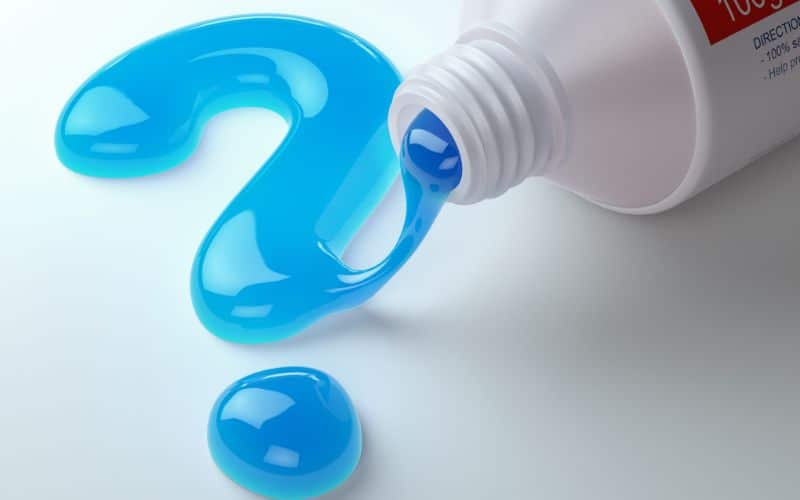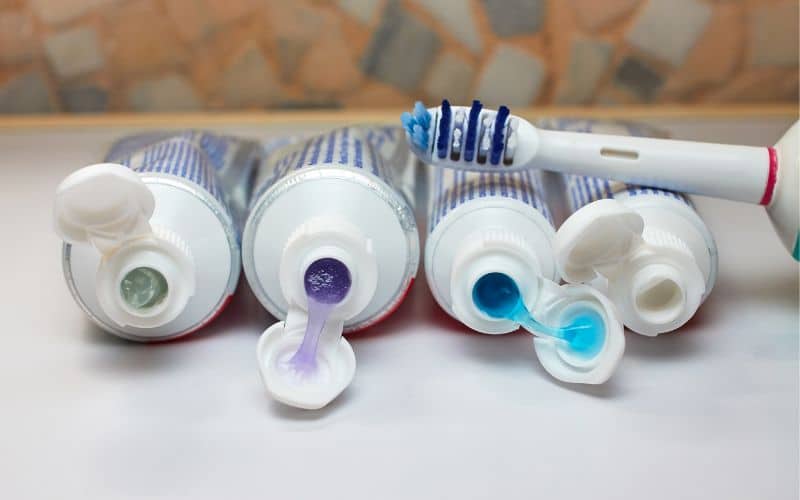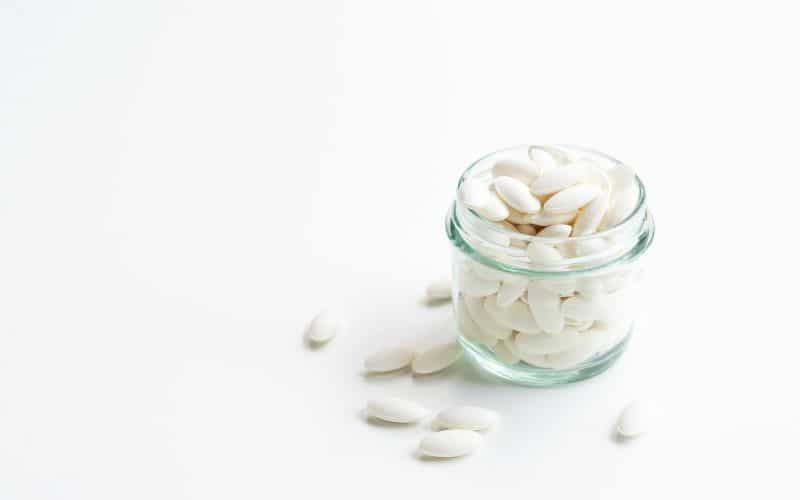When it comes to oral health, brushing your teeth twice a day with the right toothpaste is crucial. With so many toothpaste options available in the market, it can be overwhelming to choose the right one. Fortunately, dentists can offer recommendations on the best toothpaste to use for optimal oral health.
Dental professionals recommend toothpaste that contains fluoride, a mineral that helps prevent tooth decay. According to the American Dental Association (ADA), fluoride toothpaste is the best option for preventing cavities. Additionally, toothpaste that has earned the ADA Seal of Acceptance has been tested and proven to be safe and effective.
Understanding Toothpaste

Toothpaste is a crucial part of dental hygiene. It helps remove plaque, fight cavities, and keep your breath fresh. However, with so many types of toothpaste available on the market, it can be challenging to choose the right one. In this section, we will discuss the active ingredients in toothpaste and what they do.
Active Ingredients
Most toothpaste contains active ingredients that help fight cavities and improve oral health. Here are some of the most common active ingredients found in toothpaste:
- Fluoride: Fluoride is the most important active ingredient in toothpaste. It helps strengthen tooth enamel, making it more resistant to decay. The American Dental Association (ADA) recommends using toothpaste with fluoride to prevent cavities. Look for toothpaste with at least 1,000 parts per million fluoride and the ADA seal of approval.
- Stannous Fluoride: Stannous fluoride is a type of fluoride that has been shown to be more effective than sodium fluoride in preventing cavities and reducing gum inflammation. It also has antibacterial properties that help fight plaque and bad breath.
- Sodium Fluoride: Sodium fluoride is another type of fluoride that is commonly used in toothpaste. It helps prevent cavities and strengthen tooth enamel.
- Natural Ingredients: Some toothpaste contains natural ingredients such as baking soda, tea tree oil, and coconut oil. These ingredients are believed to have antibacterial and anti-inflammatory properties that help fight plaque and gum disease.
- Organic Ingredients: Organic toothpaste is made with natural and organic ingredients. These toothpaste are free of synthetic chemicals and preservatives. They may contain ingredients such as aloe vera, peppermint oil, and chamomile extract.
In conclusion, when choosing toothpaste, it’s essential to look for one that contains fluoride and has the ADA seal of approval. Other active ingredients such as stannous fluoride and natural or organic ingredients may also be beneficial. However, it’s important to note that toothpaste alone cannot replace proper oral hygiene practices such as brushing twice a day, flossing, and visiting your dentist regularly.
The Role of Fluoride
Fluoride is a naturally occurring mineral that can help prevent tooth decay and cavities. It works by strengthening the enamel on your teeth, making them more resistant to acid attacks from bacteria in your mouth.
According to the American Dental Association (ADA), fluoride is one of the most effective ways to prevent tooth decay and cavities. All toothpastes with the ADA’s Seal of Acceptance contain fluoride, which is proven to be effective in fighting cavities.
However, it’s important to use fluoride toothpaste correctly. Children under the age of 3 should use a smear of toothpaste about the size of a grain of rice, while children between the ages of 3 and 6 should use a pea-sized amount. Adults should use a pea-sized amount of toothpaste as well.
While fluoride is an important part of oral health, it’s possible to get too much of it. Fluorosis is a condition that occurs when too much fluoride is ingested during the development of teeth, causing white spots or streaks on the teeth. However, the risk of fluorosis is low when fluoride is used correctly.
In summary, fluoride is a mineral that helps prevent tooth decay and cavities by strengthening the enamel on your teeth. All toothpastes with the ADA’s Seal of Acceptance contain fluoride, and it’s important to use fluoride toothpaste correctly to avoid the risk of fluorosis.
Types of Toothpaste

When it comes to choosing the right toothpaste, there are many options available. Some toothpastes are designed to whiten teeth, while others are formulated for sensitive teeth or made with natural ingredients. Here are some of the most common types of toothpaste recommended by dentists:
Whitening Toothpaste
Whitening toothpaste is designed to help remove surface stains on teeth and make them appear brighter. These toothpastes often contain ingredients like hydrogen peroxide, baking soda, or activated charcoal. However, it’s important to note that while some whitening toothpastes can be effective, they may not be suitable for everyone. It’s always best to talk to your dentist before using a whitening toothpaste, especially if you have sensitive teeth or existing dental work.
Sensitive Toothpaste
If you experience tooth sensitivity, a toothpaste designed for sensitive teeth may be a good option for you. These toothpastes typically contain ingredients like potassium nitrate or strontium chloride, which can help reduce sensitivity. Sensodyne is a popular brand of toothpaste for sensitive teeth that is recommended by many dentists.
Natural Toothpaste
Natural toothpaste is made with ingredients like baking soda, tea tree oil, or coconut oil instead of synthetic chemicals. These toothpastes are often fluoride-free, making them a good option for people who prefer to avoid fluoride. However, it’s important to note that fluoride is a key ingredient for preventing tooth decay, so it’s important to talk to your dentist before using a fluoride-free toothpaste.
Kids Toothpaste
Toothpaste designed for kids is formulated with milder ingredients and often comes in fun flavors like bubblegum or strawberry. These toothpastes may also contain fluoride, but in lower concentrations than adult toothpaste. It’s important to supervise young children when they brush their teeth and make sure they use only a pea-sized amount of toothpaste.
Overall, choosing the right toothpaste depends on your individual needs and preferences. It’s always best to talk to your dentist before making any changes to your oral care routine.
Importance of Dental Hygiene
Maintaining good dental hygiene is crucial for overall health. Poor oral hygiene can lead to various dental problems such as cavities, gum disease, bad breath (halitosis), and other issues. Taking good care of your teeth and gums can help prevent these problems before they start.
Brushing and Flossing

Brushing your teeth twice a day with fluoride toothpaste is the foundation of good oral hygiene. Use a soft-bristled brush to remove plaque and food particles from your teeth and gums. Brush your teeth for at least two minutes each time. Don’t forget to brush your tongue to remove bacteria and freshen your breath.
Flossing is also an important part of dental hygiene. It helps remove plaque and food particles from between your teeth and along the gum line. Use dental floss or a special brush or wooden or plastic pick recommended by a dental professional. Or try a floss holder, floss threader, or water flosser.
Mouthwash
Mouthwash can be a helpful addition to your dental hygiene routine. It can help remove food particles left after brushing and flossing and freshen your breath. Look for a mouthwash that contains fluoride and xylitol, which can help prevent cavities and promote oral health.
Diet and Nutrition
Eating a healthy diet and limiting sugary food and drinks is essential for good oral health. A diet rich in fruits, vegetables, whole grains, and lean protein can help keep your teeth and gums healthy. Avoid sugary and acidic foods and drinks that can erode tooth enamel and lead to cavities.
In conclusion, maintaining good dental hygiene is essential for overall health. Brushing and flossing, using mouthwash, and eating a healthy diet are all important components of a good oral hygiene routine. By following these simple steps, you can help prevent dental problems and keep your smile healthy and bright.
Common Dental Conditions
Dental problems are common and can be caused by various factors such as poor oral hygiene, genetics, and lifestyle choices. Here are some of the most common dental conditions and how they can be prevented:
Tooth Decay and Cavities
Tooth decay is caused by the buildup of plaque, a sticky film of bacteria that forms on teeth. Plaque produces acid that can erode tooth enamel, leading to cavities. Symptoms of tooth decay include sensitivity to hot and cold foods, pain when biting down, and visible holes in teeth.
To prevent tooth decay, it is important to practice good oral hygiene by brushing twice a day with a fluoride toothpaste, flossing daily, and visiting the dentist regularly. A healthy diet that is low in sugar and high in calcium can also help prevent tooth decay.
Gingivitis
Gingivitis is a common form of gum disease that is caused by the buildup of plaque on teeth and gums. Symptoms of gingivitis include red, swollen, and bleeding gums.
To prevent gingivitis, it is important to practice good oral hygiene by brushing twice a day with a fluoride toothpaste, flossing daily, and visiting the dentist regularly. A healthy diet that is low in sugar and high in vitamin C can also help prevent gingivitis.
Sensitivity

Tooth sensitivity is a common condition that can cause pain or discomfort when eating or drinking hot or cold foods. It is caused by exposed tooth roots or worn tooth enamel.
To prevent sensitivity, it is important to practice good oral hygiene by brushing twice a day with a fluoride toothpaste, flossing daily, and visiting the dentist regularly. Using a toothpaste specifically designed for sensitivity relief can also help alleviate symptoms.
In conclusion, dental problems can be prevented by practicing good oral hygiene, maintaining a healthy diet, and visiting the dentist regularly. If you experience any dental problems, it is important to seek treatment from a qualified dental professional.
Choosing the Right Toothpaste
Choosing the right toothpaste can be overwhelming with so many options available on the market. However, it’s important to choose a toothpaste that meets your specific needs. In this section, we’ll discuss the factors you should consider when choosing a toothpaste.
ADA Recommendations
The American Dental Association (ADA) recommends using toothpaste that contains fluoride to prevent tooth decay. Toothpaste with the ADA Seal of Acceptance has been tested and proven to be safe and effective for oral health. Look for the ADA Seal of Acceptance on the toothpaste’s packaging to ensure that it meets the ADA’s standards.
For Specific Conditions
If you have specific dental concerns, you may need to use a toothpaste that is designed to address those issues. For example, if you have sensitive teeth, you may want to use a toothpaste that is specifically formulated for sensitive teeth. Sensodyne is a popular brand that offers toothpaste for sensitive teeth. If you have gum disease or bleeding gums, you may want to use a toothpaste that is designed to treat those conditions, such as Parodontax. Crest Pro Health is another popular brand that offers toothpaste for gum health.
Anti-Cavity Toothpaste
Anti-cavity toothpaste is designed to prevent tooth decay. Colgate is a popular brand that offers anti-cavity toothpaste. Fluoride is the active ingredient in anti-cavity toothpaste that helps prevent tooth decay. However, if you prefer a fluoride-free toothpaste, there are options available on the market. Just be aware that fluoride is an important ingredient in preventing tooth decay.
In conclusion, choosing the right toothpaste is important for maintaining good oral health. Look for toothpaste with the ADA Seal of Acceptance and consider your specific dental needs when choosing a toothpaste. Whether you need anti-cavity toothpaste, toothpaste for sensitive teeth, or toothpaste for gum health, there is a toothpaste out there that will meet your needs.
Emerging Toothpaste Technologies
The toothpaste industry is constantly evolving, with new technologies and innovations being introduced to the market. Here are some emerging toothpaste technologies that are worth keeping an eye on:
Tablets

Toothpaste tablets are an eco-friendly alternative to traditional toothpaste. They come in small, solid form and are usually packaged in recyclable or compostable materials. To use them, you simply chew the tablet and then brush your teeth with a wet toothbrush. These tablets are convenient for travel, as they take up less space and are not subject to TSA liquid restrictions. They are also great for reducing plastic waste, as they eliminate the need for plastic toothpaste tubes.
Smart Toothpaste
Smart toothpaste is a new technology that uses sensors to track your brushing habits. The toothpaste contains microsensors that detect how long and how well you are brushing your teeth. This information is then sent to an app on your phone, which provides feedback and tips on how to improve your brushing technique. Some smart toothpastes also contain ingredients that can help prevent cavities and gum disease.
Nanotechnology
Nanotechnology is a rapidly developing field that has the potential to revolutionize toothpaste. Nanoparticles are tiny particles that can penetrate deep into the tooth enamel and remove stains and bacteria. Some toothpastes already contain nanoparticles, which can help whiten teeth and prevent cavities. However, there are concerns about the safety of these particles, as they are so small that they could potentially enter the bloodstream and cause health problems.
Tech-Enhanced Toothbrushes
While not technically a toothpaste technology, tech-enhanced toothbrushes are worth mentioning. These toothbrushes use advanced sensors and algorithms to track your brushing habits and provide feedback on how to improve your technique. Some even come with built-in cameras that allow you to see inside your mouth while you brush. These toothbrushes can be expensive, but they are great for people who are serious about their oral hygiene.
Overall, these emerging toothpaste technologies show great promise for improving oral health and reducing waste. It will be interesting to see how these technologies develop and become more widely available in the coming years.
Ethical Considerations in Toothpaste Choice
When choosing a toothpaste, it’s important to consider not only its effectiveness but also its ethical implications. Here are some ethical considerations to keep in mind:
Vegan Toothpaste
For those who follow a vegan lifestyle or simply prefer to avoid animal products, there are several vegan toothpaste options available. These toothpastes are made without any animal-derived ingredients or byproducts, such as glycerin (which can be derived from animal fat) or animal-derived enzymes. Some popular vegan toothpaste brands include Tom’s of Maine, Dr. Bronner’s, and Hello.
Sustainability
Toothpaste packaging can have a significant impact on the environment. Look for toothpaste that comes in recyclable or biodegradable packaging, such as cardboard or metal tubes. Some toothpaste brands also offer refillable options to reduce waste. Additionally, consider the environmental impact of the toothpaste ingredients themselves. Some toothpastes contain microbeads, which can harm marine life when they enter waterways. Look for toothpaste brands that are committed to sustainability and reducing their environmental impact.
Cruelty-Free
Animal testing is still a common practice in the cosmetics industry, including toothpaste. Look for toothpaste brands that are certified cruelty-free by organizations such as Leaping Bunny or PETA. These brands do not test their products on animals or use ingredients that have been tested on animals.
In summary, when choosing a toothpaste, consider the ethical implications of its ingredients and packaging. Look for vegan, sustainable, and cruelty-free options to make a more conscious choice.



